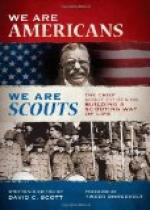By the time we had finished that meal there was a dozen or more of his uncle Chiefs at the wigwam, and we took our places for the peace smoke.
I will explain to the reader what the peace smoke is. We all took seats in a circle around the head Chief. He lighted the peace pipe, which is a special pipe kept to use on these occasions alone. He took the first whiff himself, blowing it up into the air, and the second whiff he blew into my face. I being his guest of honor, I sat at the right of him. The third whiff he blew into the face of the Chief who sat on his left, and then he passed the pipe to me. I went through the same performance and passed the pipe to the next, and so the pipe went around the circle until all had smoked, and in all the time this smoking was going on there was not a smile or a grunt or a word spoken. Every motion was in the most solemn way throughout the whole performance. As the last one finished smoking, he passed the pipe to the head Chief, and all of the Chiefs sprang to their feet and shook hands with me, from the head Chief down, and the peace smoke was over.
I will say here for the instruction of the reader that the Indians never held a peace smoke with others than the members of their own tribe, without they had perfect confidence in the outsider, who always occupied the seat of honor at the right side of the head Chief of the tribe.
After the peace smoke was over, everybody left the wigwam and everyone, Chief, warriors, and squaws, all joined in the peace dance, I of course taking a part with the rest. I never knew how many took a part in the dance that night, which is always danced in a circle, and every Indian has his or her own way of dancing, and all, old and young, male and female, that take a part are singing.
It would be impossible to explain to the people of this age so they would understand just what a peace dance is and how the people who took part in it looked with the camp fires throwing their lurid light through the darkness of the forest, lighting up the savage faces of the red men, and the not-much-less wild faces of the squaws. It was a strange sight then. How much more strange it would look to the people of this later civilization.
The dance lasted half an hour or more, and all the Indians of both sexes then shook hands with me. I shook the Chief’s hand last of all, and as I did so, I gave him the other knife I had brought with me. He took it and, brandishing it over his head, he shouted as loud as he could yell, which was a signal for all the others to yell too and shake their hands towards me. By my giving these knives to the head Chief of the tribe, I cemented the friendship of him and through him of the whole tribe more than I should if I had presented each one of his warriors with a knife.
Amidst the yells of the warriors and their squaws, I left them and walked back to camp, well satisfied with what I had done towards protecting the train as it passed through the Comanche country, for I knew we would not have any trouble with the Indians of that tribe.




